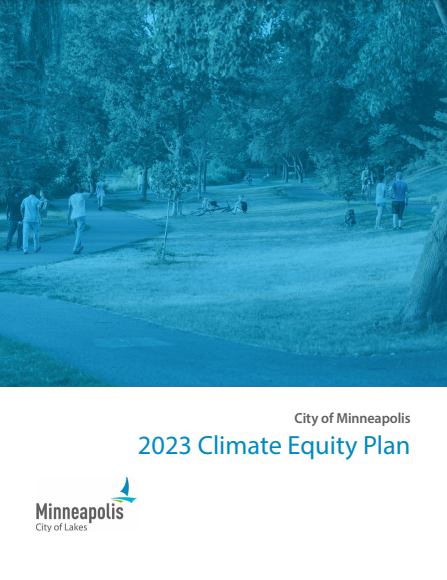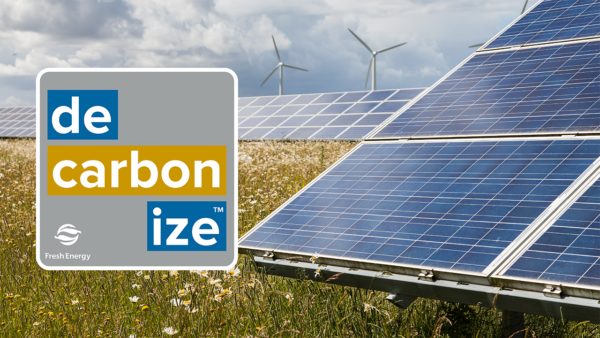
On July 20, 2023, the Minneapolis City Council voted to adopt a Climate Equity Plan which updates the city’s commitment to addressing greenhouse gas emissions, air pollution, and how the benefits of climate solutions are felt community wide. Additionally, the City Council approved the Climate Legacy Initiative on October 19, 2023. This policy will provide critical funding to help implement the Climate Equity Plan with approximately $8-10 million annually for residents as well as commercial and industrial properties, starting in 2024.
There are a lot of great components included in the 95-page plan. As part of my role as co-chair of the Minneapolis Community Environmental Advisory Commission, I had the opportunity—alongside many other Minneapolis residents, organizations, and advocates—to participate in the collaborative formation of this plan, so I wanted to take some time to highlight some of my favorite aspects for those who may not yet be familiar:
Collaborative process
The Climate Equity Plan sets goals for the city of Minneapolis over the next several decades and has a broad reach—from air quality to workforce development to transportation. To inform the direction of the plan, Minneapolis Sustainability staff proactively sought feedback on what should be included. Because respondents to traditional channels of feedback—such as online surveys—tend not to be representative of the racial, economic, and age diversity of the city, the Sustainability team took a different approach. This time, before the plan was drafted, staff met with several cultural-based groups throughout the city and tabled at community events, asking residents open-ended questions like, “What are Minneapolis’ greatest strengths?” and “What opportunities do you see for improvement?” These personal discussions helped inform the plan.
Additionally, the drafters of the plan tapped into local expertise. A Steering Committee was recruited to provide ideas and feedback during drafting, which were folded into the final version. Plus, Working Groups were formed for the specific topics of the document—such as Buildings and Industry, Economy and Workforce, Green Space and Trees—to weigh in on the details. The process in all lasted from February 2022 to its final passage in July 2023, resulting in an ambitious and holistic set of goals, strategies, and actions for Minneapolis.
Prioritizing Green Zones
The Minneapolis Climate Equity Plan centers equity in both name and content. There are two designated environmental justice areas, known as Green Zones, within Minneapolis where there is more concentrated pollution as well as racial, political, and economic marginalization. These neighborhoods will be the top priority for investment from the city. This includes a strategy to decrease the percentage of income a household spends on utilities by weatherizing homes, building out rooftop solar, planting trees and increasing the quantity and quality of green spaces, abating lead in homes, improving air quality, and more. A commitment to Green Zones is an important step in addressing historic planning and policy decisions that were based on racism.
Greenhouse gas reduction goals are front-loaded
Greenhouse gas emissions accumulate in the atmosphere over time. And while it is imperative to reach net-zero emissions globally by 2050, more harm can be avoided if we reach that goal as quickly as possible. Additionally, in comparison to cities across the world, Minneapolis’ existing infrastructure and resources means the city is well-equipped to decarbonize at a fast pace. The Climate Equity Plan incorporates these principles, and the greenhouse gas emissions goals are weighted toward the next six and one-half years. The first benchmark is an ambitious 75% emissions reduction by 2030. This goal creates an appropriate sense of urgency for drawing down city-wide emissions as quickly as possible and recognizes that Minneapolis has the tools it needs to get there.
Citywide weatherization
Weatherization—the process of insulating a home to reduce the energy required to heat and cool it, also known in the field as “tightening the envelope” of a home—has cost, emissions, health, safety, and comfort benefits. The cheapest, lowest-emitting source of energy is the energy you never have to use. The Climate Equity Plan includes a strategy to insulate and weatherize every one- to four-unit home by 2040, starting with the Green Zones.
In a city where we experience several days below zero degrees in a typical winter, an increasing number of days above 100 degrees in the summer, and have an abundance of old and leaky buildings, energy efficiency provides significant cost savings for residents and reduces emissions associated with heating and cooling. Being better equipped to control the temperature of a home—especially during extreme temperatures—is also important for health and quality of life. The Climate Equity Plan prioritizes weatherizing Green Zones first, making sure lower-income areas see the associated monthly cost savings and other benefits.
Importantly, making sure a home is well-insulated is also an important first step in home electrification, which is necessary to zero-out citywide emissions. This ensures an efficient electric heating system is sized correctly for the space, and you are not paying a premium on the initial purchase or ongoing operation of your all-electric system. Citywide weatherization will improve the quality of our homes, reduce monthly bills, and provide near-term and long-term emissions reductions.
Assignments to departments/12-month plan
The Climate Equity Plan not only sets goals, but it also serves as a work plan for city leadership, staff, and other stakeholders. Each “Strategy” listed in the plan is assigned to (at least) one department that will be responsible for carrying it out. There is also a 12-Month Plan, so the city has a roadmap for immediate action steps. These aspects provide clarity and accountability to ensure the Climate Equity Plan is not just a plan but will spark city-wide work that is necessary for seeing it to fruition.
With the creation of the Climate Equity Plan, Minneapolis has created a roadmap for the future and is making financial investments to fund the work. Going forward, it will not only fall on city leaders and staff to follow through but also on community members and stakeholders like us to help track the progress and make sure the city is living up to its commitments. More and more, we are seeing examples of local governments stepping up to take local action on climate, a strategy that is complemented by recent local government provisions from the 2023 session of the Minnesota Legislature. You can read about some of the climate-friendly, local government provisions here. Stay tuned for updates!


